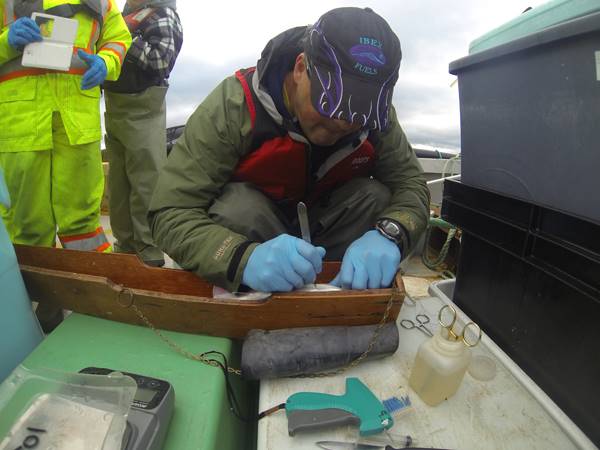Farmed salmon escape gives Newfoundland a chance to track ecosystem effects
In September 2013, about 20,000 farmed salmon went on the lam after escaping their sea cage off Newfoundland’s southern coast. The mass breakout drew the attention of Canada’s Department of Fisheries and Oceans, but rather than attempting a futile roundup the department decided to turn the slippery fugitives into unwitting participants in a grand experiment.
Earlier research from countries like Ireland and Norway showed that farmed salmon tend to move inland and interbreed with their wild counterparts, in some cases overtaking native populations. But the waterways of Newfoundland had never shown evidence of this during previous escapes, so the DFO jumped on the opportunity to observe one on a mass scale.
During the event, the DFO noticed that many of the escaped salmon had congregated in just two rivers.
“To use a popular Newfoundland saying, you could’ve walked across the brooks on the back of the salmon — they were that abundant,” said Geoff Perry, director of aquaculture management with the DFO.
So the following summer, the DFO sampled some young of the year from those two rivers, and contrary to leading fishery research, they found no evidence of any escapee successfully reproducing, much less crowding out the native stock.
“It was very bizarre,” Perry said.
Fast-forward to the present day, where Perry and the DFO are as puzzled as ever about their exceptional little island. Determined to get some answers, the DFO is conducting another experiment to understand the impact of farmed salmon escapes in Newfoundland. This time, they’re simulating five escape events by releasing groups of up to 90 tagged salmon, each representing a variety of size classes.
“What we hope to do is detect the movement of these simulated escapes to get a better understanding of how they move, when they move, how long do they survive, and when — if at all — do they enter freshwater,” Perry said.

DFO science technician Curtis Pennell makes an incision in a farmed Atlantic salmon where a small transmitter will be implanted in the abdominal cavity. (Credit: DFO Photo)
Telemetry receivers deployed throughout coastal waters and along rivers will help the department’s researchers monitor the released salmon remotely, while members of the Miawpukek First Nation from Conne River will conduct manual tracking.
The DFO is also considering reinstating experimental fishing licenses that would allow anglers to keep salmon larger than 70 cm — the size Perry says separates wild salmon from the larger farmed variety. Twenty-five of these licenses were issued during the past two fishing seasons, the only cost being access to the receiving angler’s logbook afterward. But only one angler managed to catch a single farmed salmon. Despite the lack of results, Perry says the collaboration is a no-brainer.
“With angling groups in Newfoundland, we share some of the same objectives,” Perry said. “We don’t want any escapes. If there are escapes, we want them cleaned up. And interbreeding between wild and farmed salmon is not desirable.
“There are very few situations where the interactions between the two are positive, for either the wild salmon or the farmed salmon.”
As history shows, however, there may little reason to fear interbreeding: It just doesn’t seem to happen in Newfoundland’s rivers and streams. Perry says the DFO researchers have a few hypotheses that could explain the phenomenon, and hopefully their current study will uncover some truth.
One hypothesis is that the low pH of Newfoundland’s waterways is preventing successful reproduction for the farmed salmon. A similar effect has been observed in rainbow trout after 60 years of attempted introduction.
Other hypotheses suggest that too few escaped salmon make it up river in the first place. Salmon hatcheries on the island use groundwater rather than surface water, leaving newborn salmon without the critical scent-based imprint that guides them back to their birth waters during spawning season. As Perry put it, “They have nowhere to go, there’s no river calling them home.”
Or, he says, it could be that male farmed salmon don’t have an instinctive aptitude for reproduction. It’s certainly not for a lack of biological faculties — many of the 2013 escapees possessed “huge gonads” and “full ovaries,” in the females’ cases. But the poor guys just don’t seem to get it.
“I hate to say this, but the males appear to be incompetent,” Perry said. “They act like pubescent boys — they release their milt wherever they can.” Any case of successful crossbreeding, he noted, is most likely to occur between a wild male and a farm-raised female.
The first two planned releases took place in September and October. Others will follow this winter, and then in the spring and summer of 2015. The DFO plans to track the tagged fish for three years, provided they survive. Regardless of whatever knowledge the research imparts in the near future, the DFO has no shortage of work ahead of them.
“I’m sure it will generate more questions than answers, and for each question it answers it will generate more,” Perry said.
But that’s about par for the course at this point, he says. Like any good escapee, there’s a lot more to these fish than meets the eye.
“My work in the last year has led me to realize that I shouldn’t predispose anything about salmon,” Perry said. “They continue to surprise me.”


Pingback: FishSens Magazine | Monitoring Impacts of Farmed Salmon Escapes on Wild Salmon Populations - FishSens Magazine